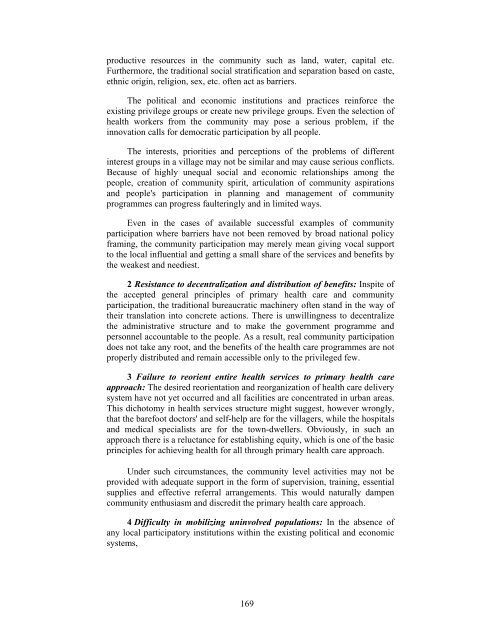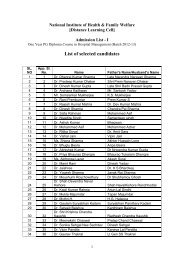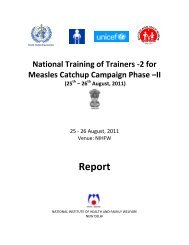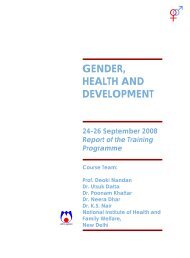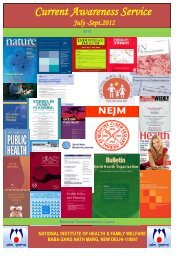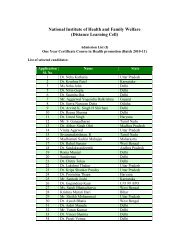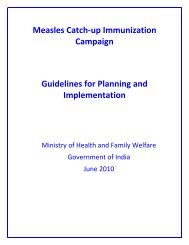COMMUNITY PARTICIPATION IN PRIMARY HEALTH CARE ...
COMMUNITY PARTICIPATION IN PRIMARY HEALTH CARE ...
COMMUNITY PARTICIPATION IN PRIMARY HEALTH CARE ...
Create successful ePaper yourself
Turn your PDF publications into a flip-book with our unique Google optimized e-Paper software.
productive resources in the community such as land, water, capital etc.<br />
Furthermore, the traditional social stratification and separation based on caste,<br />
ethnic origin, religion, sex, etc. often act as barriers.<br />
The political and economic institutions and practices reinforce the<br />
existing privilege groups or create new privilege groups. Even the selection of<br />
health workers from the community may pose a serious problem, if the<br />
innovation calls for democratic participation by all people.<br />
The interests, priorities and perceptions of the problems of different<br />
interest groups in a village may not be similar and may cause serious conflicts.<br />
Because of highly unequal social and economic relationships among the<br />
people, creation of community spirit, articulation of community aspirations<br />
and people's participation in planning and management of community<br />
programmes can progress faulteringly and in limited ways.<br />
Even in the cases of available successful examples of community<br />
participation where barriers have not been removed by broad national policy<br />
framing, the community participation may merely mean giving vocal support<br />
to the local influential and getting a small share of the services and benefits by<br />
the weakest and neediest.<br />
2 Resistance to decentralization and distribution of benefits: Inspite of<br />
the accepted general principles of primary health care and community<br />
participation, the traditional bureaucratic machinery often stand in the way of<br />
their translation into concrete actions. There is unwillingness to decentralize<br />
the administrative structure and to make the government programme and<br />
personnel accountable to the people. As a result, real community participation<br />
does not take any root, and the benefits of the health care programmes are not<br />
properly distributed and remain accessible only to the privileged few.<br />
3 Failure to reorient entire health services to primary health care<br />
approach: The desired reorientation and reorganization of health care delivery<br />
system have not yet occurred and all facilities are concentrated in urban areas.<br />
This dichotomy in health services structure might suggest, however wrongly,<br />
that the barefoot doctors' and self-help are for the villagers, while the hospitals<br />
and medical specialists are for the town-dwellers. Obviously, in such an<br />
approach there is a reluctance for establishing equity, which is one of the basic<br />
principles for achieving health for all through primary health care approach.<br />
Under such circumstances, the community level activities may not be<br />
provided with adequate support in the form of supervision, training, essential<br />
supplies and effective referral arrangements. This would naturally dampen<br />
community enthusiasm and discredit the primary health care approach.<br />
4 Difficulty in mobilizing uninvolved populations: In the absence of<br />
any local participatory institutions within the existing political and economic<br />
systems,<br />
169


